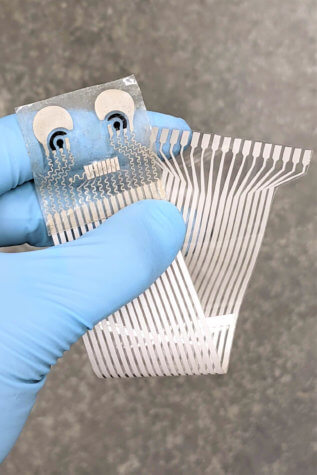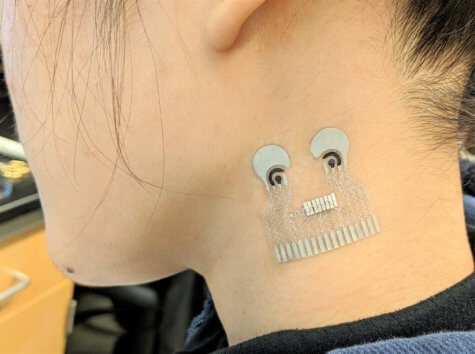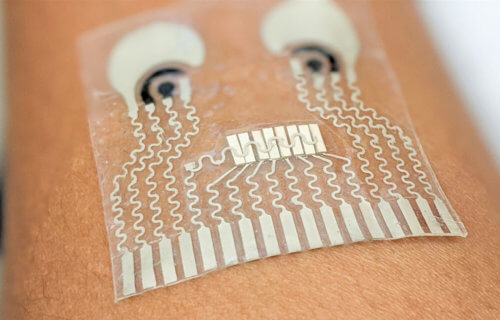SAN DIEGO — A new health super sensor has been developed to regulate everything from blood pressure to how much you have had to drink. The soft and stretchy patch is the first wearable device to monitor both cardiovascular signals and biochemical levels in the human body at the same time. Worn on the neck, it tracks the wearer’s blood pressure and heart rate, while measuring their glucose, lactate, alcohol, and caffeine levels.
Researchers say that people who suffer from blood conditions like diabetes or who are at high risk of becoming seriously ill with COVID-19 could really benefit. “This type of wearable would be very helpful for people with underlying medical conditions to monitor their own health on a regular basis. It would also serve as a great tool for remote patient monitoring, especially during the COVID-19 pandemic when people are minimizing in-person visits to the clinic,” says study lead author Lu Yin, a doctoral student at the University of California at San Diego, in a statement.

The researchers combined wearable sensors, designed to measure multiple signals with electronic skin patches. “Each sensor provides a separate picture of a physical or chemical change. Integrating them all in one wearable patch allows us to stitch those different pictures together to get a more comprehensive overview of what’s going on in our bodies,” says co-author Professor Sheng Xu.
A sheet of stretchy polymers was equipped with a blood pressure sensor and two chemical sensors. The blood pressure sensor, which sits near the center of the patch, sends ultrasound waves into the body. When they bounce back off an artery, the sensor detects the echoes and translates the signals into a blood pressure reading.
At the same time, two electrodes, printed with conductive ink, can monitor the wearers’ lactate, caffeine, and alcohol levels. They do so by releasing a drug called pilocarpine into the skin, which makes the wearer sweat. According to researchers, chemical substances in the sweat can then be detected.
“Let’s say you are monitoring your blood pressure, and you see spikes during the day and think that something is wrong. A biomarker reading could tell you if those spikes were due to an intake of alcohol or caffeine. This combination of sensors can give you that type of information,” said co-author Juliane Sempionatto, a doctoral student.
Putting the super sensor health patch to the test
To test the patch, people were asked to wear one on their neck while performing various tasks. This included exercising on a stationary bicycle, eating a high-sugar meal, and drinking an alcoholic or caffeinated beverage. The patch’s results “closely matched” measurements from trusted commercial monitoring devices such as a blood pressure cuff, blood lactate meter, glucose meter and breathalyzer.
Eliminating interference between the sensors’ signals was one of the biggest challenges. To overcome this, the researchers had to figure out the optimal spacing between the blood pressure sensor and chemical sensors. They found that one centimeter of spacing deterred interference while keeping the device as small as possible.

Each sensor is normally equipped with a hydrogel in order to produce clear readings. Making sure the blood pressure sensor’s liquid ultrasound gel didn’t interfere with the others was another challenge. “Finding the right materials, optimizing the overall layout, integrating the different electronics together in a seamless fashion–these challenges took a lot of time to overcome,” explains co-author Muyang Lin, a doctoral student.
A new version of the patch with even more sensors is already in the works. “There are opportunities to monitor other biomarkers associated with various diseases. We are looking to add more clinical value to this device,” says Sempionatto.
The researchers are hoping to make the blood pressure sensor smaller by shrinking the electronics. “Right now, the sensor needs to be connected to a power source and a bench top machine to display its readings. The ultimate goal is to put these all on the patch and make everything wireless. We want to make a complete system that is fully wearable,” says Lin.
The findings are published in the journal Nature Biomedical Engineering.
SWNS writer Tom Campbell contributed to this report.


I was looking for information on machine health monitoring. I have a lack of information about remote health monitoring with devices. I read your article and it provides me the great information about the vision for remote health monitoring with devices. Very informative article. Looking forward to more articles.